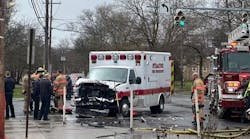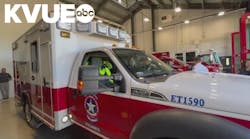Several dynamics are changing the course of fire apparatus design during a time when we are "trying to do more with less." First is the impact of our country's economy and the resulting deployment strategies within fire departments.
In some instances, the result has been reduced staffing on engine and ladder company units; in other communities, fewer companies are responding on the initial alarm in an effort to reduce costs and the associated wear and tear on apparatus. The end result in many cases is having to bring more tools and equipment to the scene of any emergency, as staffing and financial resources no longer can support multiple pieces of apparatus with staffing of four or five personnel on each unit. Whether by design or circumstances forced upon us, departments will continue to respond to incidents with their available resources to work to effectively mitigate the condition.
The apparatus that we design today are called upon to do a multitude of duties, which requires larger, multi-function apparatus with increased compartment space for personnel, tools and equipment. When you consider the cubic-foot storage capacity of the aluminum or stainless-steel body on your apparatus, this space is some of the most expensive storage space that you will ever purchase. For this reason, it is incumbent upon your apparatus committee to carefully evaluate how this enclosed compartment space is going to be used.
Consider for a moment the standard equipment that must be carried by an engine company: nozzles, fittings, adapters, hand tools, AED, self-contained breathing apparatus (SCBA) with spare bottles, forcible entry tools, high-rise hosepacks, extinguishers, hose clamp, portable monitor, tool box and many other items. How you decide to lay out and mount this equipment will have a direct impact on your fireground operations, training and maintenance of the equipment on the unit. The time spent in the design process of determining exactly where the equipment is going to be mounted before the engineering conference will assist both the department and the manufacturer to properly locate adjustable shelves, slide trays, tool boards and divider walls within the apparatus body.
Several fire companies in Cumberland County, PA, have taken delivery of newer units that exemplify well-designed body compartments with properly secured tools and equipment. The Empire Friendship Fire Company in Carlisle operates a 2008 Sutphen pumper as Engine 45 and responds to over 550 calls each year. The engine was designed to operate as an attack unit and is equipped with a 2,000-gpm pump, 1,000-gallon water tank, 20 gallons of Class A foam with CAFS, and a 100-gallon Class B foam cell. Engine 45 carries nine pre-connected attack lines together with three-inch leader lines and 1,500 feet of five-inch supply line.
The tools and equipment on this engine were mounted by members of the fire company who are trade craftsmen working with a combination of wooden tool boards and mounting hardware. Each piece of equipment carried on the engine is mounted with similar equipment, such as foam appliances, rural water equipment and extinguishers, which are carried to minimize the amount of space required to store each item. The Empire Friendship Fire Company set out to design a pumper that could make a good accounting of itself at the scene of any incident and with the combination of multiple attack lines, Class A and Class B foam capability and the extensive equipment inventory, Engine 45 is an excellent example of the well-developed engine company.
Some departments may take advantage of having their tools and equipment mounted at the manufacturer's facility or the dealer's location; however, this requires some coordination to have all of the appliances, tools and fittings shipped to the builder's location at the appropriate time. In addition, unless your department is acquiring all new equipment with the apparatus, it may not be feasible to have some of your equipment removed from in-service apparatus to have it sent out to the factory location.
From a financial viewpoint, having custom-made mounting brackets for each piece of equipment together with using fire service-grade hardware for mounting within body compartments can add to the cost of the unit. For pumpers, plan on spending $5,000 to $8,000 for tool and equipment mounting as a minimum. Remember that any equipment that is carried inside of the cab must be enclosed within an enclosed compartment or carried in a certified 9G bracket. Better yet, carefully consider what you must carry in the cab interior and mount the hand tools adjacent to the cab on the exterior or where personnel will exit the crew-cab area.
The Upper Frankford Fire Company operates an engine, engine tanker, brush unit and several support units as Company 48 in Cumberland County. All tools and equipment carried on the company's apparatus were mounted and labeled by members of the fire company. Engine 148 is a 2008 KME Predator pumper equipped with a 1,750-gpm pump and 1,000-gallon water tank with a 20-gallon Class A foam tank. The department designed this unit to serve as the primary response unit on structural fires and automobile accidents. With this in mind, Engine 148 carries six pre-connected attack lines, 1,400 feet of five-inch supply line, an Amkus rescue tool system, four gas-powered saws and full complement of hand tools. This unit, together with Engine 248, a 2000 Spartan/Four Guys engine tanker, provide a great deal of fire attack capabilities for any incident.
Both of these units have each piece of equipment down to individual mountings for adapters, nozzles and fittings mounted and labeled within each body compartment. Department members used varnished hardwood fastened on the vertical surface of the high side compartments and inside of adjustable slide trays for equipment mounting. Then, using a commercial labeling machine, each piece of equipment was marked and identified on each shelf, slide tray and tool board. This makes equipment identification simple and easily shows when a piece of equipment is missing at the scene of any incident.
This style of tool mounting takes some time and talent to properly locate everything that we carry on our apparatus, but the dividends are large when considering the ease of training, tool maintenance and incident operations where you can account for each piece of equipment on the apparatus. The Upper Frankford Fire Company operates several well-designed apparatus that provide both safety and efficiency on the fireground.
Tool and equipment mounting can be considered to be the "icing on the cake" when it comes to apparatus design. The difference between a well-designed unit where every piece of equipment is properly secured and mounted and one where tools are lying on the floor, fittings are carried in a used milk crate and forcible entry tools are hidden behind a fire extinguisher is in the final details. The time spent up front in the planning process will pay big dividends in the end when the apparatus is delivered and placed into service. If your department is in the process of specifying a new piece of apparatus, take the time to visit stations like those in Carlisle and Upper Frankford to gain some ideas and find out how other fire companies operate with their apparatus.
TOM SHAND, a Firehouse® contributing editor, is a 33-year veteran of the fire service and works with Michael Wilbur at Emergency Vehicle Response, consulting on a variety of fire apparatus and fire department master-planning issues. MICHAEL WILBUR, a Firehouse® contributing editor, is a lieutenant in the New York City Fire Department, assigned to Ladder Company 27 in the Bronx, and has served on the FDNY Apparatus Purchasing Committee. He consults on a variety of apparatus-related issues around the country. For further information, access Wilbur's website at www.emergencyvehicleresponse.com.






